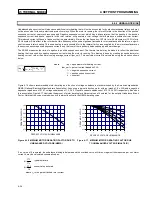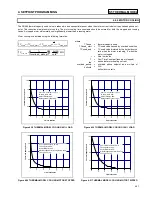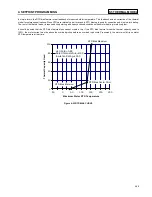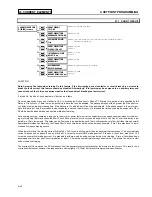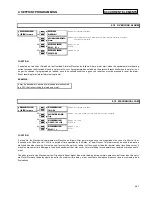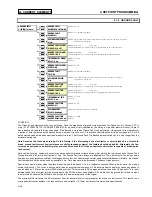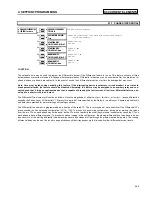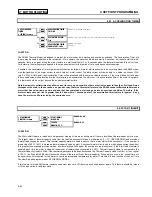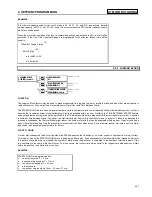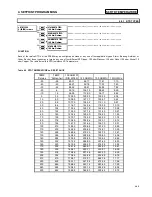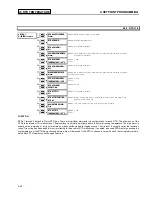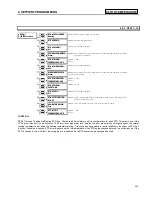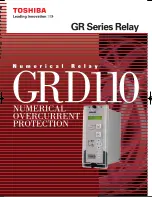
4. SETPOINT PROGRAMMING
S7 MOTOR STARTING
4-47
EXAMPLE:
If the thermal capacity used for the last 5 starts is 24, 23, 27, 25, and 21% respectively, learned
starting capacity is 27% x 1.25= 33.75% used. If the motor stops with 90% thermal capacity used, a
start block will be issued.
When the motor has cooled and the level of thermal capacity used has fallen to 66%, a start will be
permitted. If the Cool Time Constant Stopped is programmed for 30 minutes, lockout time will be
equal to:
TCused= TCused_start(e
-t/
τ
)
66%=90%(e
-t /30
)
t= ln (66/90) x -30
t= 9.3 minutes
4.8.3
JOGGING BLOCK
y
#
-2**,1*
#
%/2&.
y
#
>(17(5@
#
IRU
#
PRUH
Õ
Õ
Õ
Õ
ENTER
ENTER
ENTER
ENTER
ESCAPE
ESCAPE
ESCAPE
ESCAPE
Ö
Ö
Ö
Ö
-2**,1*
#
%/2&.
=
2II
B1>75*ð?^äð?VV
Û
Û
Û
Û
ESCAPE
ESCAPE
ESCAPE
ESCAPE
MESSAGE
MESSAGE
MESSAGE
MESSAGE
Ú
Ú
Ú
Ú
0$;
1#
67$576
2
+285
3(50,66,%/(
=#6
B1>75*ð!ðãð%
CD5@*ð!
Û
Û
Û
Û
ESCAPE
ESCAPE
ESCAPE
ESCAPE
MESSAGE
MESSAGE
MESSAGE
MESSAGE
×
×
×
×
7,0(
#
%(7:((1
#
67$576
3(50,66,%/(
=#43#
PLQ
B1>75*ð ðãð%
CD5@*ð!
FUNCTION:
The Jogging Block feature may be used to prevent operators from jogging the motor (multiple starts and stops that are performed in
rapid succession.) It consists of two distinct elements, Starts/Hour and Time Between Starts.
The STARTS/HOUR feature does not guarantee that a certain number of starts or start attempts will be allowed within an hour, rather, it
ensures that a certain number of start attempts will not be exceeded within an hour. Similarly, the TIME BETWEEN STARTS feature
does not guarantee another start will be permitted if the Time Between Starts time elapses after the most recent start; rather, it ensures
a minimum time between starts. If however, the first start attempt from cold is unsuccessful due to a jam or it takes long because the
process is overloaded, the Thermal Model might reduce the number of starts that can be attempted within an hour. It may also cause a
lockout time that exceeds a Time Between Starts lockout that may have been active. Such a thermal lockout will remain until the motor
has cooled to an acceptable temperature for a start.
STARTS / HOUR
A motor start is assumed to be occurring when the SR469 measures the transition of no motor current to some value of motor current.
At this point, one of the STARTS/HOUR timers is loaded with 60 minutes. Even unsuccessful start attempts will be logged as starts for
this feature. Once the motor is stopped, the number of starts within the past hour is compared to the number of starts allowable. If the
two numbers are the same, a block will occur. If a block occurs, the lockout time will be equal to the longest time elapsed since a start
within the past hour, subtracted from one hour.
EXAMPLE:
STARTS/HOUR are programmed at 2,
•
one start occurs at T = 0 min,
•
a second start occurs at T = 17 min,
•
the motor is stopped at T = 33 min,
•
a block occurs
•
the lockout time would be 1 hour - 33 min = 27 min
Summary of Contents for SR469
Page 7: ......
Page 19: ...2 INSTALLATION MECHANICAL 2 5 2 1 5 TERMINAL LOCATIONS Figure 2 11 TERMINAL LAYOUT...
Page 21: ...2 INSTALLATION ELECTRICAL 2 7 Figure 2 12 TYPICAL WIRING DIAGRAM...
Page 32: ...ELECTRICAL 2 INSTALLATION 2 18 2 2 14 TYPICAL 2 SPEED MOTOR WIRING...
Page 39: ...OVERVIEW 3 SR469 OPERATION 3 6 yy SETPOINTS yy S1 SR469 SETUP...
Page 104: ...4 SETPOINT PROGRAMMING S11 MONITORING 4 65 Figure 4 24 TRIP COIL SUPERVISION...
Page 113: ...S12 ANALOG I O 4 SETPOINT PROGRAMMING 4 74...
Page 244: ...8 469PC PROGRAM WAVEFORM CAPTURE 8 13 Figure 8 11 WAVEFORM CAPTURE...




